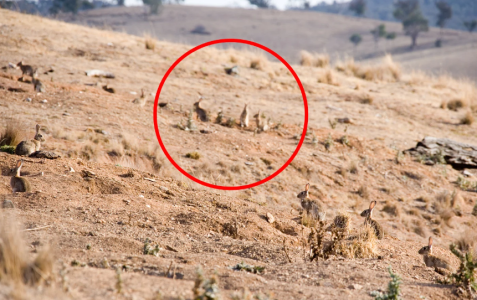Australia’s quiet crisis is back—and experts say it’s ‘about to explode’
By
Maan
- Replies 13
Easter celebrations often bring familiar traditions, from chocolate eggs to bunny-themed décor.
But behind the holiday cheer, an unexpected concern is quietly growing across the country.
What seems like a seasonal symbol is, in fact, at the centre of a much larger issue—one that could have lasting consequences for Australia’s environment and native wildlife.
As Aussie households geared up for Easter festivities, experts raised alarms over a very different kind of bunny making its presence felt across the country.
Feral rabbits—long considered one of Australia's most destructive invasive pests—were on the brink of another explosion in numbers, with around 200 million already scattered across the landscape.
Favourable seasonal conditions, combined with the species developing resistance to current biocontrol efforts, had created a perfect storm for population growth.
Jack Gough, CEO of the Invasive Species Council (ISC), warned: ‘Rabbits are one of our worst pests, they're not just one of our cute and cuddly animals.’
‘They were able to spread across the whole continent, and it's had enormous consequences for our native wildlife and agriculture productivity.’
Introduced in the 1850s by European settlers for sport, rabbits had continued to push out native species like quolls, possums and bandicoots.
Heidi Kleinert, national rabbit management coordinator at the ISC, previously explained how quickly they could multiply: ‘Because rabbits can breed every 28 days — and as soon as they give birth, they can fall pregnant again—one pair of rabbits can breed up to 184 young in 18 months.’
The ISC warned in a public statement that: ‘Recent season conditions mean the estimated 200 million rabbit population is likely about to explode, just as federal funding for the next killer virus runs dry.’
Australia had previously relied on biological controls, like calicivirus, to manage rabbit numbers, but those tools were rapidly losing effectiveness.
‘The most recent release of a strain of calicivirus, which is the virus that really has knocked down their population, is now about 10 years old,’ Gough said.
‘[Its ability] to reduce the population is significantly starting to decline.’
Despite the growing crisis, federal funding for rabbit management programs had stopped in 2022, leaving no coordinated national approach in place.
Gough stressed: ‘At the moment, we don't have a national strategy that is funded by the government. That really needs to change. This should be a national priority... It shouldn't matter who's in government... This is something that should always have funding behind it.’
With up to 300 native species facing extinction as a direct result of rabbit overpopulation, the environmental consequences were becoming increasingly severe.
Gough warned that failure to act could cause irreversible damage to Australia's ecosystem.
‘The diversity of native species is part of the fabric of Australian life, part of what Australians are really proud to sort of be custodians of,’ he said.
‘Wildlife is at the heart of who we are as Australians...[if we don't find a solution] this is going to be an issue that Australia has to deal with forever.’
Researchers were now exploring cutting-edge gene drive technologies as a new method to curb the rabbit crisis.
These tools aimed to genetically engineer rabbits to pass on traits—such as infertility or single-sex offspring—that could collapse populations over time.
By altering inheritance patterns, scientists hoped to reduce breeding success and gain an upper hand in the battle against this resilient pest.
In a previous story, we covered how pest populations surged in the wake of recent cyclone events.
That threat is still unfolding, with communities battling widespread damage to local ecosystems.
To understand how these outbreaks are connected, you can read more here.

With rabbits continuing to wreak havoc across the country, could genetic engineering be the breakthrough solution Australia needs? Let us know your thoughts in the comments.
But behind the holiday cheer, an unexpected concern is quietly growing across the country.
What seems like a seasonal symbol is, in fact, at the centre of a much larger issue—one that could have lasting consequences for Australia’s environment and native wildlife.
As Aussie households geared up for Easter festivities, experts raised alarms over a very different kind of bunny making its presence felt across the country.
Feral rabbits—long considered one of Australia's most destructive invasive pests—were on the brink of another explosion in numbers, with around 200 million already scattered across the landscape.
Favourable seasonal conditions, combined with the species developing resistance to current biocontrol efforts, had created a perfect storm for population growth.
Jack Gough, CEO of the Invasive Species Council (ISC), warned: ‘Rabbits are one of our worst pests, they're not just one of our cute and cuddly animals.’
‘They were able to spread across the whole continent, and it's had enormous consequences for our native wildlife and agriculture productivity.’
Introduced in the 1850s by European settlers for sport, rabbits had continued to push out native species like quolls, possums and bandicoots.
Heidi Kleinert, national rabbit management coordinator at the ISC, previously explained how quickly they could multiply: ‘Because rabbits can breed every 28 days — and as soon as they give birth, they can fall pregnant again—one pair of rabbits can breed up to 184 young in 18 months.’
The ISC warned in a public statement that: ‘Recent season conditions mean the estimated 200 million rabbit population is likely about to explode, just as federal funding for the next killer virus runs dry.’
Australia had previously relied on biological controls, like calicivirus, to manage rabbit numbers, but those tools were rapidly losing effectiveness.
‘The most recent release of a strain of calicivirus, which is the virus that really has knocked down their population, is now about 10 years old,’ Gough said.
‘[Its ability] to reduce the population is significantly starting to decline.’
Despite the growing crisis, federal funding for rabbit management programs had stopped in 2022, leaving no coordinated national approach in place.
Gough stressed: ‘At the moment, we don't have a national strategy that is funded by the government. That really needs to change. This should be a national priority... It shouldn't matter who's in government... This is something that should always have funding behind it.’
With up to 300 native species facing extinction as a direct result of rabbit overpopulation, the environmental consequences were becoming increasingly severe.
Gough warned that failure to act could cause irreversible damage to Australia's ecosystem.
‘The diversity of native species is part of the fabric of Australian life, part of what Australians are really proud to sort of be custodians of,’ he said.
‘Wildlife is at the heart of who we are as Australians...[if we don't find a solution] this is going to be an issue that Australia has to deal with forever.’
Researchers were now exploring cutting-edge gene drive technologies as a new method to curb the rabbit crisis.
These tools aimed to genetically engineer rabbits to pass on traits—such as infertility or single-sex offspring—that could collapse populations over time.
By altering inheritance patterns, scientists hoped to reduce breeding success and gain an upper hand in the battle against this resilient pest.
In a previous story, we covered how pest populations surged in the wake of recent cyclone events.
That threat is still unfolding, with communities battling widespread damage to local ecosystems.
To understand how these outbreaks are connected, you can read more here.
Key Takeaways
- Experts warned of a looming rabbit population boom in Australia, with around 200 million feral rabbits already present.
- The species had developed resistance to calicivirus, and federal funding for new biocontrols ended in 2022.
- Native wildlife and agriculture continued to suffer, with up to 300 species at risk of extinction.
- Scientists were now considering gene drive technology to reduce rabbit fertility and slow population growth.
With rabbits continuing to wreak havoc across the country, could genetic engineering be the breakthrough solution Australia needs? Let us know your thoughts in the comments.








